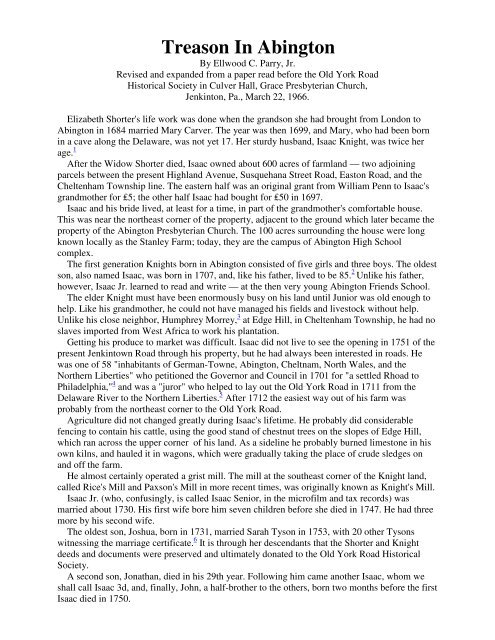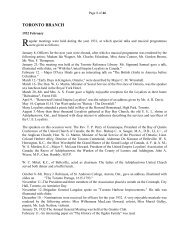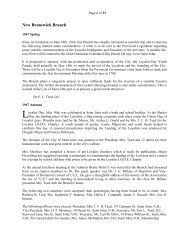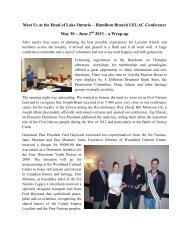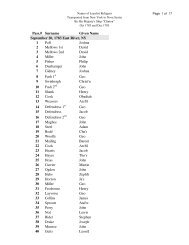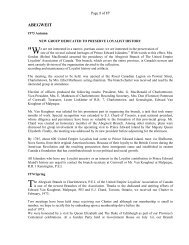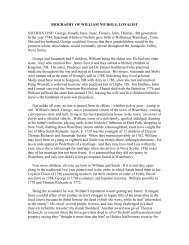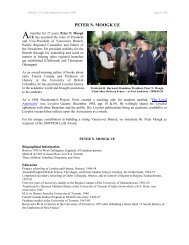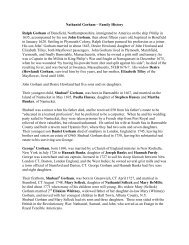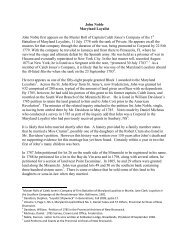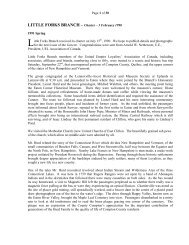Treason In Abington - for United Empire Loyalists
Treason In Abington - for United Empire Loyalists
Treason In Abington - for United Empire Loyalists
Create successful ePaper yourself
Turn your PDF publications into a flip-book with our unique Google optimized e-Paper software.
<strong>Treason</strong> <strong>In</strong> <strong>Abington</strong><br />
By Ellwood C. Parry, Jr.<br />
Revised and expanded from a paper read be<strong>for</strong>e the Old York Road<br />
Historical Society in Culver Hall, Grace Presbyterian Church,<br />
Jenkinton, Pa., March 22, 1966.<br />
Elizabeth Shorter's life work was done when the grandson she had brought from London to<br />
<strong>Abington</strong> in 1684 married Mary Carver. The year was then 1699, and Mary, who had been born<br />
in a cave along the Delaware, was not yet 17. Her sturdy husband, Isaac Knight, was twice her<br />
age. 1<br />
After the Widow Shorter died, Isaac owned about 600 acres of farmland — two adjoining<br />
parcels between the present Highland Avenue, Susquehana Street Road, Easton Road, and the<br />
Cheltenham Township line. The eastern half was an original grant from William Penn to Isaac's<br />
grandmother <strong>for</strong> ₤5; the other half Isaac had bought <strong>for</strong> ₤50 in 1697.<br />
Isaac and his bride lived, at least <strong>for</strong> a time, in part of the grandmother's com<strong>for</strong>table house.<br />
This was near the northeast corner of the property, adjacent to the ground which later became the<br />
property of the <strong>Abington</strong> Presbyterian Church. The 100 acres surrounding the house were long<br />
known locally as the Stanley Farm; today, they are the campus of <strong>Abington</strong> High School<br />
complex.<br />
The first generation Knights born in <strong>Abington</strong> consisted of five girls and three boys. The oldest<br />
son, also named Isaac, was born in 1707, and, like his father, lived to be 85. 2 Unlike his father,<br />
however, Isaac Jr. learned to read and write — at the then very young <strong>Abington</strong> Friends School.<br />
The elder Knight must have been enormously busy on his land until Junior was old enough to<br />
help. Like his grandmother, he could not have managed his fields and livestock without help.<br />
Unlike his close neighbor, Humphrey Morrey, 3 at Edge Hill, in Cheltenham Township, he had no<br />
slaves imported from West Africa to work his plantation.<br />
Getting his produce to market was difficult. Isaac did not live to see the opening in 1751 of the<br />
present Jenkintown Road through his property, but he had always been interested in roads. He<br />
was one of 58 "inhabitants of German-Towne, <strong>Abington</strong>, Cheltnam, North Wales, and the<br />
Northern Liberties" who petitioned the Governor and Council in 1701 <strong>for</strong> "a settled Rhoad to<br />
Philadelphia," 4 and was a "juror" who helped to lay out the Old York Road in 1711 from the<br />
Delaware River to the Northern Liberties. 5 After 1712 the easiest way out of his farm was<br />
probably from the northeast corner to the Old York Road.<br />
Agriculture did not changed greatly during Isaac's lifetime. He probably did considerable<br />
fencing to contain his cattle, using the good stand of chestnut trees on the slopes of Edge Hill,<br />
which ran across the upper corner of his land. As a sideline he probably burned limestone in his<br />
own kilns, and hauled it in wagons, which were gradually taking the place of crude sledges on<br />
and off the farm.<br />
He almost certainly operated a grist mill. The mill at the southeast corner of the Knight land,<br />
called Rice's Mill and Paxson's Mill in more recent times, was originally known as Knight's Mill.<br />
Isaac Jr. (who, confusingly, is called Isaac Senior, in the microfilm and tax records) was<br />
married about 1730. His first wife bore him seven children be<strong>for</strong>e she died in 1747. He had three<br />
more by his second wife.<br />
The oldest son, Joshua, born in 1731, married Sarah Tyson in 1753, with 20 other Tysons<br />
witnessing the marriage certificate. 6 It is through her descendants that the Shorter and Knight<br />
deeds and documents were preserved and ultimately donated to the Old York Road Historical<br />
Society.<br />
A second son, Jonathan, died in his 29th year. Following him came another Isaac, whom we<br />
shall call Isaac 3d, and, finally, John, a half-brother to the others, born two months be<strong>for</strong>e the first<br />
Isaac died in 1750.
So, as the events in the Province built toward the coming Revolution, the land, except <strong>for</strong><br />
about 100 acres at the Cheltenham Township end, which, from the evidence of the recording of<br />
earlier deeds, apparently had been sold about 1756, was divided among four Knights: Isaac Jr.,<br />
Joshua, Isaac 3d, and John.<br />
Isaac Jr., on the Property Tax list of 1769, was assessed <strong>for</strong> 300 acres, three horses, and nine<br />
cattle. 7 This made him the second largest landholder in the township, and his tax of ₤45 13s. was<br />
the fifth highest. Actually the assessment understated his holding by about 100 acres.<br />
That same year, Joshua (his oldest son) is listed as owning 140 acres, two horses, and four<br />
cattle. 8 He was also a blacksmith, and ten of his acres were "on the York Road near the Meeting<br />
House," 9 adjoining land of Abraham Tyson (the tax assessor that year), and others. A stone house<br />
and smithy stood on his land in Jenkintown, and he made his home there. Since the farm was<br />
mortgaged <strong>for</strong> ₤200 in 1778, 10 he may have used that money to acquire the Jenkingtown property<br />
and set up his blacksmith shop.<br />
The two younger brothers were not assessed until the Provincial Tax of 1774. <strong>In</strong> that year,<br />
Isaac Jr. is shown as holding 150 acres; Joshua, the same 140; Isaac 3d, 200; and John, who was<br />
also a tanner, 100. The combined tax was a sizable ₤78. 11 Isaac 3d was listed as having a servant.<br />
Surveyors sketched some or all of these holdings in 1779, 12 1789, 1793, and 1814. 13 From their<br />
maps and descriptions accompanying later transfers, it is possible to locate quite accurately how<br />
Isaac Jr. divided his land among his sons. His namesake was given the choice 105 acres in the<br />
eastern corner — the ground which Elizabeth Shorter had reserved <strong>for</strong> herself in the deed of<br />
1699. 14 Joshua's ground was the north corner; that is, at Susquehanna Street Road and the present<br />
Easton Road. John's acreage was irregularly shaped, with about five-eighths of a mile frontage on<br />
the road running northeast from Weldon. Isaac Jr. kept the heart of the 500 acres, with the most<br />
of his frontage on the road to the mill (Highland Avenue).<br />
An examination of the surveyor's sketches reveals that considerable attention was paid in the<br />
subdividing process to giving each farm access to the springs and streams; the springs <strong>for</strong><br />
household use; the streams <strong>for</strong> the cattle. Isaac Jr. was careful to see that his own land was well<br />
watered in three or four places.<br />
All three sons of Isaac Jr. preferred the British cause. This powered many mills on its<br />
meandering course through Cheltenham Township be<strong>for</strong>e it became the Frank<strong>for</strong>d Creek.<br />
The Knight family had arrived at the eve of the Revolution, a time when Quakers, particularly,<br />
found themselves balanced precariously on the fence of divided loyalties. They were certainly<br />
aware of the Testimony of the Philadelphia Meeting on January 24, 1775:<br />
We have by repeated public advices and private admonitions used our<br />
endeavors to dissuade the members of our religious society from joining<br />
with the public resolutions prompted and entered into by some people<br />
which, as we apprehended, so we now find, have increased contention,<br />
and produced great disorder and confusion . ...From our past experience<br />
of the clemency of the King, we believe that decent and respectable<br />
addresses would avail towards obtaining and restoring the public<br />
tranquility! - and we deeply deplore that contrary modes of proceeding<br />
have involved the colonies in confusion. 15<br />
This was signed by James Pemberton, clerk, one of the 20 so-called Virginia Exiles, 17 of<br />
whom were Quakers, banished from Philadelphia in 1777 "to keep the peace." Isaac Jr. and his<br />
sons knew and respected Pemberton, who is described as a man of "punctilious probity ... almost<br />
the last of the race of the ‘cocked hats’, ... and primitive men." 16<br />
Isaac Jr., too, was highly respected, both among Friends and neighbors. Although he was<br />
nearing 70 in the winter of 1774-75, he was named by the people of the Province to a Committee<br />
of Correspondence and <strong>In</strong>spection, 17 to act under the provisions of the "Association" agreement
of Congress, to attempt to establish a unified policy among the various colonies toward the<br />
oppressive acts of the British. He was one of the 40 chosen from the County of Philadelphia,<br />
which then included the future Montgomery County, and all the outlying townships and boroughs<br />
of the future city.<br />
It is difficult today to re-create the mental and economic anguish the Knights endured during<br />
the Revolution. They had their strong religious conviction that any kind of fighting was wrong,<br />
but many of their friends and neighbors, even some of the Quakers, had taken up arms. They<br />
could not be, even if they wished, completely neutral, because they had to sell their produce<br />
somewhere. If they took it to Philadelphia, occupied by the British in 1777, they became the<br />
lawful prey of Continental scouting parties. If they sold to Washington's troops, they ran the<br />
double risk of not being paid, and of having the British attack them <strong>for</strong> their ef<strong>for</strong>ts.<br />
Foraging parties from both sides, in scouring the countryside, could hardly have missed their<br />
productive 500 acres, either. The Tyson's, who were both neighbors and relatives, during 1777<br />
and 1778, "suffered greatly from British soldiers skirmishing through the Sandy Run valley,<br />
robbing their granaries, their stores of beef and other supplies, and driving off their best horses<br />
and other livestock." 18 Taxes, too, became increasingly onerous, and, if they refused to drill on<br />
Militia Days (which they did), the taxes were automatically doubled or tripled.<br />
All three sons of Isaac Jr. preferred the British cause. This in itself was neither unusual nor<br />
surprising. Probably two-thirds of the population of the Province of Pennsylvania felt the same<br />
way. Even the Continental Congress, as late as January 2, 1776, was not too concerned about this<br />
disaffection, but urged the committees of safety "to treat all such persons [<strong>Loyalists</strong>] with<br />
kindness and attention; to consider them as the inhabitants of a country determined to be free, and<br />
to view their errors as proceeding from want of in<strong>for</strong>mation rather than want of virtue or public<br />
spirit." 19 That attitude was soon to change.<br />
The Knights, however, carried their convictions further than most, and were accused of treason<br />
as a result. On May 8, 1778, their names were listed on the first proclamation of attainder issued<br />
by the Supreme Executive Council of the Commonwealth of Pennsylvania "against certain named<br />
persons adjudged guilty of high treason" <strong>for</strong> having "severally adhered to & knowingly & willing<br />
aided & assisted the Enemies of this State & of the <strong>United</strong> States of America, by having joined<br />
their Armies at Philadelphia, in the County of Philadelphia, within this State." 20 They were given<br />
until Thursday, the 25th of June, to surrender themselves <strong>for</strong> trial or stand attained of High<br />
<strong>Treason</strong>.<br />
Isaac 3d surrendered, and was subsequently discharged by proclamation when no witnesses<br />
appeared against him. Joshua, the oldest, and John, the youngest, did not. <strong>In</strong> May of 1778 they<br />
were 46 and 28, respectively. <strong>In</strong> the eyes of many of their neighbors they were traitors. The<br />
penalty was confiscation by the State of all their real estate and personal property.<br />
What Joshua and John did specifically to aid the British cause was not stated in the<br />
proclamation against them, although John is listed elsewhere 21 as having been a guide. Whatever<br />
they did to incur the wrath of their neighbors could not have been trivial. It was certainly not just<br />
because they were Quakers, no matter how outspoken.<br />
Although the Quakers had been reviled during the French and <strong>In</strong>dian War <strong>for</strong> not fighting <strong>for</strong><br />
the King, and now <strong>for</strong> not fighting against him, the number of persons of all faiths actually<br />
accused of treason was so small as to be insignificant. <strong>In</strong> all of what was to become Montgomery<br />
County only about 47 had this dubious distinction, and some of them were acquitted or<br />
discharged. The Knights, with one possible exception, were the only ones from <strong>Abington</strong>.<br />
Some of the those accused surrendered, like Isaac 3d, but had to stand trial. Thomas McKean,<br />
a signer of the Declaration of <strong>In</strong>dependence, and, in 1778, Chief Justice of Pennsylvania,<br />
presided at 16 trials between September and December. Two of those convicted were hanged.<br />
Some called it "an example;" others, "judicial murder." One was John Roberts, wealthy and<br />
influential miller of Lower Merion, who had served on the same Committee of Correspondence<br />
as Isaac Knight Jr.
Among the documents preserved by the Tyson family was a letter which set off the search into<br />
the brothers' Loyalist activities. The return address was simply "Beaver Harbour," and the date<br />
was April 7th, 1787 — four years after the end of the Revolution. It was sent to Isaac Knight<br />
Senior (whom we know as Junior) in care of James Pemberton, Philadelphia — the same James<br />
Pemberton who had been exiled ten years earlier <strong>for</strong> being outspoken in his Quaker anti-war<br />
beliefs.<br />
Honoured Father<br />
I have to trouble thee once more concerning my losses, having been be<strong>for</strong>e<br />
the Commissioners to prove my claims and, falling short of authentick proofs<br />
as to the confiscation and sales to their satisfaction, was desired by them to<br />
procure the condemnation or an acknowledge[ment] of the commissioners that<br />
seized and sold the property with the prices sold <strong>for</strong> or even one of their<br />
Advertisements <strong>for</strong> the sale. Thy procuring the above vouchers will be of<br />
infinite servis to me as I have nothing in my possession to prove the<br />
confiscation nor attainder of my pirson and it is necessary <strong>for</strong> me to prove both<br />
- there<strong>for</strong>e beg that every exertion be mad[e] use of to obtain the proofs<br />
discribed as the whole depends on these things:-<br />
this has been the hardest winter ever known by the oldest inhabitant in this<br />
country; the snow is between two & three feet deep on a level in the woods at<br />
this time; there has been upwards of fifty moos[e] killed within six weeks in<br />
this settlement which has been a grate relief to the <strong>In</strong>habitants, provision being<br />
very scant, many families not having a mouthful of meat nor bread <strong>for</strong> some<br />
weeks be<strong>for</strong>e.-<br />
as to health, we are in a bad state, my wife has been confin'd to the house<br />
most of the winter and is not any better yet. I am much troubled with the<br />
rheumatick pains so as to disable me from work. John's wife has been sick this<br />
three weeks past and not any better.-<br />
so concluding with love to thee and all our relations and friends, not<br />
<strong>for</strong>getting our children.<br />
Joshua Knight<br />
<strong>In</strong> an atlas it takes but a moment to locate Beaver Harbour — a small village in New<br />
Brunswick, less than 20 miles across open water from the eastern tip of Maine.<br />
So the story unfolds: Joshua and John were among the estimated 100,000 Loyalist, then three<br />
per cent of the white population of the new <strong>United</strong> States, who fled from the northern states to the<br />
Maritime Provinces of Nova Scotia and New Brunswick, and from the southern states to the<br />
Bahamas and Florida, to escape the animosity and even violence of their nieghbors. 23 Only a<br />
handful, of course, had actually been accused of treason.<br />
A few of the more moderate Whigs recognized the absurdity of persecuting the Tories after the<br />
war was over. They argued that these misguided people had lost all political influence anyway, so<br />
it would be better to allow them to stay in the <strong>United</strong> States than to drive them off to found an<br />
unfriendly colony to the north. But those who argued thus, no matter how conspicuous their own<br />
service had been in the Continental cause, ran the risk, almost literally, of being tarred with the<br />
same stick.<br />
The British government undertook a huge task in evacuating the Tories, giving them land, and<br />
indemnifying them <strong>for</strong> their losses in the States. Even if the promised 200 acres of farmland <strong>for</strong><br />
the head of each family did not always materialize, Parliament did pay out about $16,000,000 by<br />
1790 to 4,000 refugees, while others received grants of crown-lands, half pay as military officers,<br />
special annuities, or civil service appointments. It might be remarked, parenthetically, that the
British took far better care of the <strong>Loyalists</strong> than Congress ever did of Washington's ragged<br />
soldiers during and after the War <strong>for</strong> <strong>In</strong>dependence.<br />
It was not until the spring of 1778, when the British were preparing to leave Philadelphia, that<br />
any concerted attempt was made to en<strong>for</strong>ce the laws passed by the Assembly against those who<br />
favored the British cause. Meanwhile, the <strong>Loyalists</strong> who had joined the British <strong>for</strong>ces in the city<br />
were becoming more and more disillusioned and apprehensive. The rebels were not being<br />
defeated fast enough, if at all, and now the British army was about to withdraw, leaving them to<br />
the untender mercies of the Whigs. Most of the Tories decided that only in flight lay safety <strong>for</strong><br />
themselves and their families until his Majesty's <strong>for</strong>ces got to work and won the war.<br />
The rear-guard of the British marched out of the city on the morning of June 18th. Be<strong>for</strong>e<br />
sundown, the Continental troops took possession of the city, and found their <strong>for</strong>mer prim and<br />
pretty Quaker town a shambles. Desolation, filth, stench, and flies were the legacy left by the foe.<br />
Since their collective losses from the wanton destruction of houses and businesses ran into<br />
hundreds of thousands of pounds, the enraged Whigs quite understandably preferred complaints<br />
against those who had assisted the British army during the occupation of Philadelphia. Joshua<br />
Knight, blacksmith; John Knight, tanner; and Isaac Knight, husbandman, were attainted even<br />
be<strong>for</strong>e the British left.<br />
Sir Henry Clinton had planned to go to New York by water, and had his transports lined up in<br />
the Delaware <strong>for</strong> that purpose, but the demands <strong>for</strong> protection from the 3,000 <strong>Loyalists</strong> who<br />
wished to go along <strong>for</strong>ced him to let them use the transports while he took his army and 12 miles<br />
of baggage wagons by land across new Jersey. 24 Philadelphia's streets were piled high with<br />
furniture and other belongings of the refugees awaiting cartage either to the wharves (to be taken<br />
along), or to auction places <strong>for</strong> public sale. As each transport was filled, it dropped down the<br />
Delaware and anchored to wait <strong>for</strong> the rest. "There they lay <strong>for</strong> a <strong>for</strong>tnight in the steaming heat of<br />
a tidewater Pennsylvania June, their unhappy passengers devoured by mosquitoes and sweltering<br />
in their crowded quarters between decks." 25<br />
Most likely they were also suffering from the anguish a gambler feels when he has staked his<br />
<strong>for</strong>tune and his future on the wrong horse. Even under the "protection" of the British they had<br />
suffered as much humiliation and financial hardship as if they had been defeated in battle. But<br />
that was only the beginning.<br />
As Joshua's letter relates, his property was "seized and sold." So was John's. The Pennsylvania<br />
Archives give the details, sometimes fragmentary, sometimes complete. Confiscation usually<br />
took the <strong>for</strong>m of an inventory of real estate and personally possessions. <strong>In</strong> Philadelphia County<br />
(as distinguished from the city itself), Col. George Smith and William McMullen, Esq., were<br />
appointed agents <strong>for</strong> the State to handle all the details of seizing and selling the properties.<br />
There is no indication that any Knight furniture or farm equipment was confiscated, but the<br />
real estate was inventoried and described.<br />
Joshua owned 100 acres bounded by Susquehanna Street Road and the properties of Jacob<br />
Lippincott, Thomas Tyson, and his two brothers. This was mortgaged <strong>for</strong> ₤200 "&in arrears." He<br />
also had two lots adjoining each other, "ye one Containing ten acres Deeded, ye other Containing<br />
twelve acres only on title Bond, Near to <strong>Abington</strong> Meeting house, Adjoining to Land of Abraham<br />
Tyson & ye Widdow Coffins and ye York Road, Whereon he Latly Lived — Concidrable in<br />
Debts by What I can find to ye amount of two hundred and ten Pounds," according to Col.<br />
Smith. 26 There was still another parcel, containing 24 acres, bounded by Susquehanna Street<br />
Road and the land of William Jenkins and Samuel Davis.<br />
These properties were not immediately sold. <strong>In</strong> fact, Sara Knight (probably Joshua's wife, the<br />
<strong>for</strong>mer Sarah Tyson) rented the Jenkintown places October 1st, 1778, at ₤10 per year. This would<br />
seem to indicate that she did not follow her husband (to whom she had been married 25 years)<br />
when he first "went over to the enemy," but continued to live in their home beside the blacksmith<br />
shop on York Road.<br />
John Knight's 107 acres were bounded by the <strong>Abington</strong> Road (part of the present Easton
Road), and properties of his father, his two brothers, Jacob Lippincott, and Rynear Tyson,<br />
Joshua's wife's grandfather. A two-story stone house stood on the property, approximately where<br />
the Casa Conti restaurant is today. There were also outhouses and lime kilns, orchard and<br />
meadow. 27 It is probable that the outhouses were used in John's tanning trade. The Archives show<br />
that the acres were rented in December 1778 <strong>for</strong> ₤50. From the evidence of tax payments made<br />
by Isaac, it appears that the two Isaacs worked Joshua's and John's land until those farms were<br />
sold, paying both rent and taxes <strong>for</strong> the privilege.<br />
Joshua's 100-acre tract was purchased on the 22d of June 1780 by Philip Moore at public sale<br />
in the city of Philadelphia (the county seat). The total purchase price was ₤29,000, three fourths<br />
of which was turned over to the Commonwealth, the other quarter reserved <strong>for</strong> the University of<br />
Pennsylvania. Moore also bought the 24-acre parcel <strong>for</strong> ₤8,000, 28 , while Joseph Dean, of the<br />
Manor of Moreland, purchased the 10 ¼ (including house and smithy) <strong>for</strong> ₤11,600. 29 The same<br />
one-quarter share was reserved <strong>for</strong> the university in each case. The records do not indicate what<br />
happened to the other 12 acres, but since they were not deeded, Joshua probably did not actually<br />
own them.<br />
No purchaser was found <strong>for</strong> John's land, so the Commonwealth eventually bid it in <strong>for</strong><br />
₤41,000, "<strong>for</strong> the use of the university, 30 on August 30, 1780. Less than three weeks be<strong>for</strong>e that,<br />
William Jenkins, tax collector <strong>for</strong> <strong>Abington</strong> Township, had received from Col. Smith ₤236 10s.<br />
"<strong>for</strong> ye months of Jan. & feby. and ye County Tax <strong>for</strong> Joshua & John Night's Estates in<br />
<strong>Abington</strong>." 31<br />
Here we must pause to explain the enormous sums paid <strong>for</strong> the properties, and the role of the<br />
University of Pennsylvania in the sale of confiscated estates.<br />
Beginning in 1777, Continental currency depreciated so rapidly :a fast trotting horse could not<br />
keep pace with it." 32 A Philadelphia merchant kept a chart showing, month by month, what 100<br />
pounds in specie were worth 33 in the "old rags and lampblack" 34 of Continental money. <strong>In</strong> August<br />
1780 it had depreciated to 70 to 1. This means, that John's farm, sold <strong>for</strong> ₤41,000, was actually<br />
worth about ₤583, or roughly $2,800. Similarly, Joshua's 100 acres, sold in June when the ratio<br />
was 64 to 1, was worth about $2,175, and the 10 ¼ acres in Jenkintown, $780.<br />
Because Dr. William Smith, Provost of the college founded by Benjamin Franklin, and some<br />
of the trustees and teachers of that institution were supposed to be tainted with too much Toryism,<br />
the Assembly, in 1779, annulled the Academy's charter and created a new institution, the<br />
University of Pennsylvania. 35 The device of giving the university 25% of the proceeds of<br />
confiscated estates was an ingenious way of endowing it without taxing the citizens of the<br />
Commonwealth. The U. of P. in most instances took the income, in cash or produce, rather than<br />
purchase money. John's estate was apparently leased to PeacockMajor, 36 an <strong>Abington</strong> farmer who<br />
had been a first lieutenant in the First Company of the Fourth Battalion. There is a note in the<br />
Archives, dated July 21, 1780, that William (probably Joseph) Dean either owed or paid "<strong>In</strong>t. on<br />
¼ ps. of Purchase Money ₤2 18s. Specie, or 5 Bushels and 8-10 of Wheat." 37<br />
Brother Isaac, meanwhile, escaped prosecution, and continued to farm his land. The Archives,<br />
in a summary account of the proceedings of agents <strong>for</strong> confiscated estates in Philadelphia, has a<br />
note: "Made an <strong>In</strong>ventory of some Iron belonging to Isaac Knight, <strong>for</strong>merly of <strong>Abington</strong>, gone<br />
with the enemy, and left them with Levis Fohrere. 38 This was dated July 23,1778. Since this was<br />
a month aftter the date set <strong>for</strong> Isaac's surrender, it could be that he had not yet been discharged, or<br />
that the agent who made the inventory confused Isaac with Joshua. It is more likely the<br />
blacksmith of the family would have the iron.<br />
By a curious coincidence, one of the Isaac's profited from the confiscation traitor's property.<br />
On November 3, 1780, Isaac Knight and David Jordan were paid ₤432 (about $28.75) "to<br />
Keeping Two horses Late the Property of Benedict Arnold Confiscated 32 Days Each @ ₤6 15s.<br />
p. Day." 39<br />
After Joshua's holdings were gone, and he personally could suffer no further loss in <strong>Abington</strong>,<br />
two members of the Tyson family came <strong>for</strong>ward with claims against the confiscated estate. The
Tysons had been conspicuously on the side of the Whigs as the Knights had been on the side of<br />
the Tories, yet Joshua had married a Tyson, and one of his sisters had married another, Jonathan,<br />
son of Derrick. The family ties seem to have been stronger than their political differences,<br />
because Abraham Tyson advanced Joshua ₤30 on June 15, 1776, and Joseph Tyson loaned him<br />
₤50 Specie on November 1, 1777. 40 Both claims were approved by the Supreme Court of<br />
Pennsylvania, and paid with interest and costs some years after the war.<br />
Most curious of all, however, is the following statement, under date of November 23, 1795 —<br />
17 years after John's flight:<br />
I, John Tyson, of the City of Philadelphia, do hereby give in<strong>for</strong>mation to<br />
his Excellency Thomas Mifflin, Esquire, Governor of the<br />
Commonwealth of Pennsylvania, That there are four hundred acres of<br />
land Situate in the Township of Haver<strong>for</strong>d and County of Delaware an<br />
undivided moiety of which stands <strong>for</strong>feited to this Commonwealth by<br />
reason of John Knight, late of Philadelphia County, having been duly<br />
attained of High <strong>Treason</strong> and that the said land is now in the Possession<br />
of Margaret Hibbird and Samuel Seedon [Leedom?]. 41<br />
One can only speculate on the motive <strong>for</strong> this late and apparently gratuitous act of in<strong>for</strong>ming,<br />
<strong>for</strong> by that time the high tide of feeling against the Tories was long past. John's mother had<br />
married Isaac Jr., at Haver<strong>for</strong>d. When she died in 1785, John was her only surviving child. This<br />
might have been a property inherited by her and then willed to him.<br />
The records do not indicate whether Joshua and John, with their wives, sailed on the transports<br />
to New York in 1778, but it is more than probable that at least the men did. It was not safe to stay<br />
behind. The next five years must have brought them alternating moments of hope and despair as<br />
the <strong>for</strong>tunes of the was ebbed and flowed, and their thoughts turned northeastward.<br />
According to Sabine, an "original agreement between the founders of Pennfield, made at<br />
Philadelphia, in 1782," 42 was placed at this disposal by a descendant of Joshua. Joshua could<br />
hardly have been in Philadelphia in 1782, but a plan did exist, and he was definitely one of the<br />
planners.<br />
"It was under this agreement that a meeting of Quakers was held at the house of Joshua Knight,<br />
36 Chatham Street, New York City, on July 5, 1783, in order to decide some matters of<br />
importance in connection with their plans." 43 Samuel Fairlamb, of Chester, George Brown, of<br />
Buckingham, and John Rankin, of York County, all similarly attainted of treason, were appointed<br />
to locate lands <strong>for</strong> the association. They petitioned, on behalf of "those Gentlemen, who by the<br />
unhappy termination of the War are obliged to leave their Homes and seek an Assylum in His<br />
Majesty's Province of Nova Scotia," <strong>for</strong> land <strong>for</strong> about 60 families. 44 The site chosen <strong>for</strong> them<br />
was at Beaver Harbour, north of the island of Grand Manan. The settlement was established in<br />
the fall of 1783, as at least 800 <strong>for</strong>mer residents of Pennsylvania poured into the Province of<br />
Nova Scotia.<br />
Colorfully, but without dates or references, Sabine relates that "early in the Revolution he<br />
[Joshua] abandoned everything, went to the Island of Campo Bello, N.B., where, <strong>for</strong> a winter, he<br />
occupied a fisherman's salt-house, or hut. Joined finally by other <strong>Loyalists</strong> from his native<br />
Province, he settled on the mainland of the Bay of Fundy at a place called Pennfield, in honor of<br />
William Penn." 45<br />
There appeared to be discrepancies in this account. Early in the Revolution there was no<br />
"N.B.," since New Brunswick did not become a separate province until 1784 — after the<br />
<strong>Loyalists</strong> settled there. Also, if Siebert's account is correct, Joshua must have been in New York<br />
in 1783, and almost certainly sailed on the Camel, 293 tons, William Tinker, master. This ship<br />
arrived at St. John on September 18, 1783, with "Loyalist and Refugees consisting of 104 men,<br />
50 women, 20 servants, as well as 47 children under the age of ten. Nearly all belonged to the
two special companies of Quakers and Anabaptists, and they were sent immediately down the<br />
Bay [of Fundy] to Beaver Harbour." 46<br />
Could Joshua have made a trial visit to the island later made famous by FDR, returning to urge<br />
his fellow <strong>Loyalists</strong> to seek their <strong>for</strong>tunes north of the border? No matter, land at Beaver Harbour<br />
he did. An old plan of the town, in the British Museum, shows 15 streets and 950 lots in the town<br />
proper, with many large farms and garden plots behind them. With an excellent harbor and good<br />
spring, the town looked impressive on paper, but rocks and swamps made farming difficult, and<br />
the settlement waned. Joshua transferred his home to Pennfield:<br />
"... the Parish of Pennfield was erected in the following year [1786]. It<br />
was agreed to build a small meeting house July 7, 1786, on ground<br />
allotted <strong>for</strong> that purpose. We are told that a fire devastated the town in<br />
1787, which must have greatly increased the distress and want among the<br />
pioneers at Pennfield. About the time of the fire, however, partial relief<br />
was af<strong>for</strong>ded through the ef<strong>for</strong>ts of two Quakers gentlemen from<br />
Philadelphia who had visited Beaver Harbour a twelfthmonth be<strong>for</strong>e, and<br />
on their return home had raised a subscription with which they bought<br />
and shipped 240 barrels of flour and <strong>In</strong>dian meal, together with some<br />
other necessaries, to be distributed amongst their destitute brethren...<br />
Whatever recovery Pennfield made from its first conflagration was<br />
wiped out by a <strong>for</strong>est fire in 1790, which left but one dwelling house<br />
standing. According to a recent writer, ‘a few inhabitants, including the<br />
family of Joshua Knight, remained or came back to rebuild their<br />
dwellings at or near the old sites’; but some of the settlers... went<br />
elsewhere. <strong>In</strong> June 1803, the population of the Parish of Pennfield which<br />
continued to consist of Quakers principally, numbered only 54. This little<br />
community occupied a good tract of land and lived chiefly by farming,<br />
although it sustained two saw-mills, and had recently launched two<br />
vessels of 250 tons each." 47<br />
Joshua symbolizes the perpetual loser — in all but courage. Even at age 60, crippled by<br />
"rheumatick pains," he built again, and lived <strong>for</strong> 15 more years in that frosty country. He must,<br />
though, have longed <strong>for</strong> the mellower climate of his native <strong>Abington</strong>; <strong>for</strong> the sight of the children<br />
he left behind; <strong>for</strong> a little of the luck or wisdom of his brother Isaac; but most of all, probably, <strong>for</strong><br />
the strength of the Friends Meeting he left behind. The Quaker delegates sent from Philadelphia<br />
to visit their brethren in the wilderness returned and "reported sadly that the meetings were not<br />
kept up and the children were not trained in the thoughts and discipline of Friends." 48<br />
Even the days of the Isaacs in <strong>Abington</strong> were numbered. The first of the three surveyor's charts<br />
preserved by the Tysons is dated April 1789. It identifies the "bounds, &c. of Land, The Trustees<br />
of the University to Peacock Major, hereto<strong>for</strong>e John Knight." This survey of the 107 acres was<br />
made "at the request of Isaac Knight [probably Isaac Jr.] and in the presence of Peacock Major<br />
and Samuel Burman, Assignee of the sd. Major by Lease." Since the tax records show that Major<br />
was in the possession of those same acres, three horses, and two cattle six years earlier, the<br />
survey was probably requested by Isaac to define his own holdings. What is curious on the<br />
sketch, however, is Jacob Lippincott's name where Isaac 3d's, had been. We can only surmise that<br />
Isaac 3d, sold his farm and moved in with his father, who was then past 80.<br />
Thomas Livezey, Surveyor, made the next sketch, on the 30th of March, 1793. It shows the<br />
boundaries of the "Plantation late of Isaac Knight the Elder deceased... containing 202 Acres &<br />
112 Perches." Isaac had died the previous September. A two-story house with two chimneys is<br />
shown on the west side of Lime Kiln (Jenkintown) Road about where <strong>Abington</strong> Avenue is now.<br />
A large barn stood north of the house, and a spring house between the house and the road.
This was soon sold, <strong>for</strong> by 1798 there were no longer any Knights among the "taxables" of<br />
<strong>Abington</strong>. <strong>In</strong> 1814 Thomas Livezey returned, and received "Four Dollars and fifty Cents in full<br />
<strong>for</strong> Surveying, calculating & drafting" this property. It was then called Jonathan Tyson's<br />
Plantation. The Tories were gone. The Whigs were here to stay.<br />
SOURCES<br />
1. Parry, E.C., "A Widow's Might," Old York Road Historical Society Bulletin, Vol. XXVII, 1966.<br />
2. Records of <strong>Abington</strong> Monthly Meeting.<br />
3. Hocker, Edward ("Norris"), Norristown Times Herald, Jan. 5, 1945.<br />
4. Logan Papers, "Petition <strong>for</strong> Road," Documents of the Provincial Council, MSS Coll., Historical Society<br />
of Pennsylvania.<br />
5. Buck, William J., "The Old York Road," The Local Historian, Hatboro "Public Spirit," Dec. 11, 1880.<br />
6. <strong>Abington</strong> M.M.<br />
7.,8.,9.,10.,11.,12., Pennsylvania Archives, Series 3 and 6.<br />
13. Collec. O.Y.R. Hist. Soc.<br />
14. Parry, op. cit.<br />
15.,16. WATSON, J.F., Annals of Philadelphia Rev. Ed., 1909, 1, 508.<br />
17. Jenkins, H.M., Memorial History of Philadelphia, 1895, 1, 329, n.<br />
18. Johnston, J.C., "The Tyson Lime Kilns, O.Y.R.H. Soc. Bulletin, Vol. III, 1939.<br />
19. Journals of Congress, IV, 18.<br />
20. Penna. Archives, Ser. 4.<br />
21. Wright, Esther C., The <strong>Loyalists</strong> of New Brunswick, (Fredericton, N.B., 1955), p. 299.<br />
22. Penna. Archives, Ser. 6, XIII, 466: "James Stevenson, late of <strong>Abington</strong> township Practitioner in Physick;<br />
Charged on the Oath of Matthais Bush & Jacob S. Miller with <strong>Treason</strong>able Practices." A Philadelphia<br />
baker named James Stevens or Stevenson was accused, surrendered, and was acquitted. It was probably<br />
the same man.<br />
23. Fiske, John, The Critical Period of American History, 1783-1789, (Boston, 1916), p. 120 ff.<br />
24. Fiske, J., The American Revolution, (Boston, 1893), 11, 58.<br />
25. Bill, A.H., Valley Forge, (New York, 1952), 183.<br />
26.,27.,28.,29.,30.,31. Penna. Arch., Ser. 6.<br />
32.,33.,34.,35. WATSON, op. cit.<br />
36. Surveyor's Chart, O.Y.R. Hist. Soc. Collec.<br />
37.,38.,39.,41., Penna. Arch., Ser. 6.<br />
42. Sabine, L., Biographical Sketches of <strong>Loyalists</strong> of the American Revolution, (Boston, 1864), 1, 607.<br />
43. Siebert, W.H., "The Loyalist of Pennsylvania," Ohio State Univ. Bulletin XXIV, No. 23, p. 101 ff.<br />
44. Wright, op. cit., p. 251.<br />
45. Sabine, op. cit.<br />
46. Wright, op. cit.<br />
47. Siebert, op. cit.<br />
48. Wright, op. cit.<br />
SOURCE: Parry, E.C., "<strong>Treason</strong> <strong>In</strong> <strong>Abington</strong>," Old York Road Historical Society Bulletin, Vol. XXVIII, 1967.<br />
http://www.rootsweb.ancestry.com/~nbpennfi/penn5<strong>Treason</strong>.htm<br />
(<strong>In</strong><strong>for</strong>mation contributed by Kathleen Smith)


